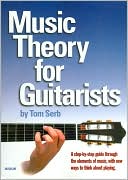

 |

|

The average rating for Music Theory for Guitarists based on 2 reviews is 4.5 stars.
Review # 1 was written on 2018-09-10 00:00:00 Sharlene C Jones Sharlene C JonesI thought it was quite good: it covers the basics and no more, in an easily-readable and logical manner. The language is American English. The contents are as follows: 01. The Characteristics of Sound 02. Rhythm 03. Notes and Rests 04. Time Classification and Time Signatures 05. More Ideas in Rhythm 06. Pitch Notation 07. Clefs 08. Scales and Modes 09. Major Scales 10. Minor Scales 11. Key Signatures 12. Key Relationships 13. Chromatic and Other Scales 14. Intervals 15. Triads 16. Chord Inversions 17. Extended Chords 18. Transposition 19. Chord Symbols and Names 20. Chord Progressions and Cadences 21. Musical Terms I did, however notice a few anomalies, e.g. • p. 38 The sign to lower notes an octave is given (like that to raise them) as 8va; whereas in my experience it's 8vb (ottava bassa) ' this is, for instance, what Finale provides. • p. 39 The guitar is asserted to be a transposing instrument, in that its music is written in the treble clef, an octave higher than it sounds. This is certainly true of older music; but modern guitar music is often written in the octave treble clef (= vocal tenor clef), and is thus at pitch. • p. 42 "In writing, an accidental will affect all the notes with that letter for the rest of the measure being played". Untrue! Accidentals apply only to the octave at which they appear ' the same note in a different octave is (or should be) unaffected. This mistake is not uncommon even in published music, so it's important to get the matter right! • p. 69ff After coverage of the standard major and minor scales, chromatic, pentatonic and blues scales are mentioned ' and there is even a list of exotic scales such as Javanese and Ethiopian. But there is no coverage of modal scales, which are fundamental to early music, and ' more importantly, possibly, to the beginning player ' folk music. For instance, someone who wants to accompany Irish dance music will find that the minor scales are not classical but Dorian (e.g. A-B-C-D-E-F#-G-A). And Flamenco also uses the Phrygian mode. • p. 90 "We can also add a major seventh to a minor triad, which gives us a minor seventh". And the example agrees, indicating it isn't a misprint. This is news to me! For 50 years I had been under the impression that a minor seventh chord contained a minor seventh interval. And in fact on the next page an "other seventh form" has the exact same example and is and labelled a major 7 flat 3rd! • p.105 Glissando is defined as "played in a harplike manner from lowest not [sic] to highest". And this certainly agrees with the first of the definitions in the Oxford Dictionary of Music. But on the guitar, the usage more commonly means sliding from one note to the other, covering the frets in between, i.e. the second meaning given ' the first is more commonly called arpeggio or arpeggiated. Still, by and large I think the virtues outweigh the deficiencies. |
Review # 2 was written on 2014-09-28 00:00:00 Valerie Brickman Valerie BrickmanIt's Christgau. Enough said. |
CAN'T FIND WHAT YOU'RE LOOKING FOR? CLICK HERE!!!